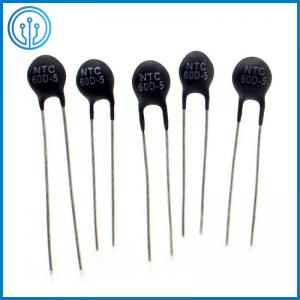
Add to Cart
General Purpose Leaded Disc NTC Negative Temperature Coefficient Thermistors 60D-5 100D-5 200D-5
Description Of The Negative Temperature Coefficient Thermistors
The Thermistor is a special type of variable resistive element that changes its physical resistance when exposed to changes in temperature.
Negative temperature coefficient of resistance thermistors, or NTC thermistors for short, reduce or decrease their resistive value as the operating temperature around them increases. Generally, NTC thermistors are the most commonly used type of temperature sensors as they can be used in virtually any type of equipment where temperature plays a role.
Features & Benefits Of The Negative Temperature Coefficient Thermistors
* Various coating and lead material options
* Multiple temperature stability options
* Customized solutions
Specification Of The Negative Temperature Coefficient Thermistors
| P/N | Rated zero power resistance @25C(Ohm) | Max stable current @25C(A) | Residual resistance at max current @25C(A) | B25/85(K) | Thermal time constant(s) | Dissipation factor(mw/C) | Certification | Operating temperature |
| 5D-5 | 5 | 1 | 0.584 | 2700 | ≤18 | ≥6 | -40~150 | CQC UL CUL TUV |
| 6D-5 | 6 | 0.7 | 0.675 | 2700 | ≥6 | -40~150 | TUV | |
| 7D-5 | 7 | 0.7 | 0.766 | 2700 | ≥6 | -40~150 | TUV | |
| 8D-5 | 5 | 0.7 | 0.857 | 2700 | ≥6 | -40~150 | TUV | |
| 10D-5 | 10 | 0.7 | 1.039 | 2700 | ≥6 | -40~150 | CQC UL CUL TUV | |
| 12D-5 | 12 | 0.6 | 1.235 | 2800 | ≥6 | -40~150 | TUV | |
| 15D-5 | 15 | 0.6 | 1.530 | 2800 | ≥6 | -40~150 | CQC UL CUL TUV | |
| 16D-5 | 16 | 0.6 | 1.628 | 2800 | ≥6 | -40~150 | TUV | |
| 18D-5 | 18 | 0.6 | 1.824 | 2800 | ≥6 | -40~150 | TUV | |
| 20D-5 | 20 | 0.6 | 2.020 | 2800 | ≥6 | -40~150 | CQC UL CUL TUV | |
| 22D-5 | 22 | 0.6 | 2.060 | 2800 | ≥6 | -40~150 | CQC UL CUL TUV | |
| 25D-5 | 25 | 0.5 | 2.123 | 2800 | ≥6 | -40~150 | TUV | |
| 30D-5 | 30 | 0.5 | 2.227 | 2800 | ≥6 | -40~150 | CQC UL CUL TUV | |
| 33D-5 | 33 | 0.5 | 2.436 | 2800 | ≥6 | -40~150 | CQC UL CUL TUV | |
| 50D-5 | 50 | 0.4 | 2.653 | 3000 | ≥6 | -40~150 | CQC UL CUL TUV | |
| 60D-5 | 60 | 0.3 | 2.753 | 3000 | ≥6 | -40~150 | CQC UL CUL TUV | |
| 200D-5 | 200 | 0.1 | 18.7 | 3000 | ≥6 | -40~150 | UL |
Typical Applications Of The Negative Temperature Coefficient Thermistors
* Alarm and temperature measurement application
* Temperature regulation application
* Level detection application
* Compensation application
Thermistor Used For Inrush Current Suppression
* We have seen here that thermistors are used as resistive temperature sensitive transducers, but the resistance of a thermistor can be changed either by external temperature changes or by changes in temperature caused by an electrical current flowing through them, as after all, they are resistive devices.
* Ohm’s Law tells us that when an electrical current passes through a resistance R, as a result of the applied voltage, power is consumed in the form of heat due to the I2*R heating effect. Because of the self-heating effect of current in a thermistor, a thermistor can change its resistance with changes in current.
* Inductive electrical equipment such as motors, transformers, ballast lighting, etc, suffer from excessive inrush currents when they are first turned “ON”. But series connected thermistors can also be used to effectively limit any high initial currents to a safe value. NTC thermistors with low values of cold resistance (at 25oC) are generally used for such current regulation.
NTC vs PTC Thermistors Of The Negative Temperature Coefficient Thermistors
| Thermistors | NTC | PTC |
| Temperature coefficient | Negative (-ve) | Positive (+ve) |
| Metal Oxides | Nickel, iron, manganese, titanium, cobalt | Strontium titanate, barium-, lead- |
| Temperature Range | -55°C to 200°C | 60°C to 120°C |
| Applications | Temperature sensing and control, flow measurement etc. | Over-current protection, self-regulating heater etc. |
